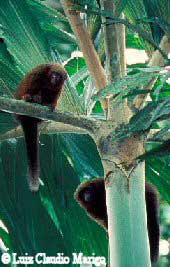 |
 |
|
» Back to Main Page » The Auction » The Winning Bid » All About Madidi » The Scientist and the Monkey » 60 Minutes Seeks The Monkey » WCS Protects Madidi Land And Species » The GoldenPalace.com Monkey » How the Monkey was Discovered » Scientists Observe Monkeys » Focus on Madidi's Diverse Wildlife  |
The Scientist and the Monkey Dr. Robert Wallace, along with his wife, works in Bolivia coordinating the Wildlife Conservation Society’s conservation program in one of the most ecologically diverse areas on Earth. They have coordinated conservation programs in protected areas of the Bolivian jungle such as Madidi, Pilon Lajas and Apolobamba that cover nearly 50 thousand square kilometers. They have helped to train Bolivian conservation workers to help work the conservation programs there and have created awareness of wildlife issues and species including the identification of the new monkey species. Wallace’s wife, Lillian has facilitated titling efforts of over 3000 square kilometers of Tacana indigenous lands and planning of the management of the protected areas of the Madidi park.
Dr. Robert Wallace, along with his wife, works in Bolivia coordinating the Wildlife Conservation Society’s conservation program in one of the most ecologically diverse areas on Earth. They have coordinated conservation programs in protected areas of the Bolivian jungle such as Madidi, Pilon Lajas and Apolobamba that cover nearly 50 thousand square kilometers. They have helped to train Bolivian conservation workers to help work the conservation programs there and have created awareness of wildlife issues and species including the identification of the new monkey species. Wallace’s wife, Lillian has facilitated titling efforts of over 3000 square kilometers of Tacana indigenous lands and planning of the management of the protected areas of the Madidi park.
 Dr. Wallace discovered the new species of titi monkey while working near the edge of the protected area of the Madidi national park. Dr. Wallace and his team extensively observed, documented, filmed and photographed this new species before proposing this new species in a document to the scientific community. The document has been approved by taxonomic experts and will be published soon.
Dr. Wallace discovered the new species of titi monkey while working near the edge of the protected area of the Madidi national park. Dr. Wallace and his team extensively observed, documented, filmed and photographed this new species before proposing this new species in a document to the scientific community. The document has been approved by taxonomic experts and will be published soon.
As the person who discovered the monkey, Dr. Wallace has the right to name it, but along with his colleagues, have decided to auction off the rights to name the new monkey species with the proceeds to go to FUNDESNAP, a non-profit organization and will be used to protect the monkey’s home in Madidi national park.  A titi monkey actually describes 30 different species of monkey all of which are located in the Amazon and Atlantic forest regions in South America. They live in small groups and weigh about 1kg. Larger primates live in larger numbers to protect themselves from jungle predators, but titi monkeys live a more hidden, secretive life in dense foliage of the mid level canopy of the jungle. They are difficult to find, but have been often heard in the mornings making their territorial callings.
A titi monkey actually describes 30 different species of monkey all of which are located in the Amazon and Atlantic forest regions in South America. They live in small groups and weigh about 1kg. Larger primates live in larger numbers to protect themselves from jungle predators, but titi monkeys live a more hidden, secretive life in dense foliage of the mid level canopy of the jungle. They are difficult to find, but have been often heard in the mornings making their territorial callings.
 The new titi monkey species has orange fur, a characteristic golden crown and a white tip on its tail. Its hands and feet are a dark red color. Similar to other titi monkeys, they are monogamous and mate for life. They constantly battle for territory with other pairs of titi monkeys and spend most of their time bonding and defending against predators. The male titi monkey usually carries infants the majority of the time until they can survive on their own.
The new titi monkey species has orange fur, a characteristic golden crown and a white tip on its tail. Its hands and feet are a dark red color. Similar to other titi monkeys, they are monogamous and mate for life. They constantly battle for territory with other pairs of titi monkeys and spend most of their time bonding and defending against predators. The male titi monkey usually carries infants the majority of the time until they can survive on their own.
|
 |
|
| Copyright © 2025 GoldenPalaceMonkey.com. All rights reserved. This site is in no way affiliated with WCS.org. |
|
